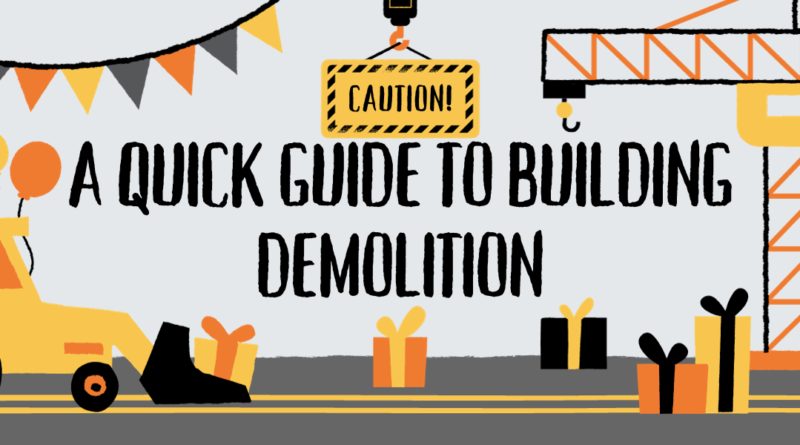A Quick Guide to Building Demolition
Building demolition is the process of disassembling, obliterating, or demolishing building structures and the materials used to make the structure. A building may be ruined for several reasons, including whether it has outlived its usefulness, the structural integrity has been threatened, some business areas need to be renovated to increase its quality and worth, or the landowner plans to sell the vacant parcel.
If a structure is not demolished when it should be, it could represent a serious threat and put the people living there and others nearby in peril. According to demolition contractor in WIlliamstown, building demolitions must be planned to avoid mishaps and casualties.
Demolition Methods
When planning to destroy a building, there are numerous factors to consider, including the building’s structure, location, materials, strength, and potential risks if the demolition is done incorrectly. The key to a safe demolition procedure is determining the optimum approach before moving forward with the plan.
Demolition techniques are separated into two groups and then further categorised into several forms of demolition. These are what they are:
1. Nonexplosive technique
The nonexplosive approach is a demolition method that uses equipment and hand tools. It works well for tearing down smaller to medium-sized buildings, such as houses or other establishments. This process makes use of:
- Bulldozers,
- Wrecking balls,
- Standard excavators and
- High-reach excavators
2. Implosive Method
Explosives are used in the implosive method, a factory demolition technique, to destroy the building’s structural supports and cause it to collapse. It works well when tearing down tall buildings or other structures. There are two methods to do this:
- Falling like a tree (i.e., implosion and sideways fall of the system)
- A building collapsing into its footprint (i.e., imploding and coming down on itself)
Demolition Process
Building demolition should follow a specific process, and by doing so, you can help ensure that it is carried out safely and methodically by following the procedures below:
1. Building Survey
Demolition contractor in WIlliamstown should examine the property’s components, including construction materials, design, usage before demolition, and building codes. An evaluation of the neighbourhood’s preference for noise and dust and any other potential effects of these kinds of activities on the area is also necessary.
The building should also be examined for radioactive, toxic, dangerous, or flammable elements. The building’s technique of construction, present structural state, structural system, and design should all be examined structurally. It would simplify choosing the most effective and safe ways to dismantle the building.
2. Remove Hazardous Materials
Before demolition, industry professionals should be called to securely remove any hazardous elements discovered during the initial examination, such as asbestos, minerals, radioactive chemicals, and flammable materials.
3. Prepare Demolition Plan
A precise strategy should outline the best way to carry out the demolition. The demolition plan should specify the specific demolition techniques to be used in each area of the building as well as the order in which they should be carried out.
Supporting information should include:
- The building’s location.
- Distance from neighbouring buildings and highways.
- Distance from sensitive areas like schools and hospitals.
All the precautions to be taken for health, safety, and waste management before, during, and after the demolition should be outlined in the plan.
How to Ensure Safety During Demolition?
To provide a safe, effective, and coordinated approach to the factory demolition procedure, all relevant workers should talk about preventive measures and hold toolbox talks.
Additionally, demolition safety indicators should be used correctly and consistently. Workers should always wear the proper protective equipment when near the structure.
Failure to follow the warnings and other crucial safety precautions can have several negative effects, such as occupational illness development, exposure to dangerous substances, and flash fires.
1. Inspect for asbestos
Before making any structural changes, an asbestos examination is essential to preventing worker exposure to asbestos materials. To guarantee that it is done safely and following the established requirements, this examination should particularly be performed by a qualified asbestos inspector.
2. Control the dumping of garbage
Garbage disposal management is required by law to protect the environment, the public’s health, and safety. Proper waste management is crucial because the demolition and construction business contributes to solid waste to ensure that all wastes and building debris—especially hazardous—are disposed of appropriately.
3. Risk Assessment
All site supervisors and associated people can stay one step ahead of the demolition process with a thorough and detailed planning stage. Risk assessments are essential for spotting potential project setbacks and foreseeing them in an industry prone to dangers. Assessments greatly reduce the likelihood of undesirable incidents by addressing the identified risks appropriately.
Demolition supervisors can use the hierarchy of controls to lower risks and hazards and establish a safe operating environment for their crew.
4. Communicate with Team
On-site people often observe daily operations. Therefore, they would be the best people to advise on safety precautions and priority issues. To increase openness and prevent incidents brought on by improper communication, the team should be encouraged to maintain continual contact.
5. Regular Inspection
By conducting routine inspections, you can ensure that all guidelines, instructions, and laws are followed regularly. It promotes consistent employee compliance and enables teams to resolve concerns before they harm the project.
Merhi Group: The Best Demolition Team in Williamstown
A brief overview of building demolition offers crucial insights into this difficult process. Fundamentals include putting safety first, careful planning, obtaining permits, and managing waste. To ensure a successful and responsible outcome that makes room for new buildings or revitalises existing areas, demolition requires skill and adherence to rules.



